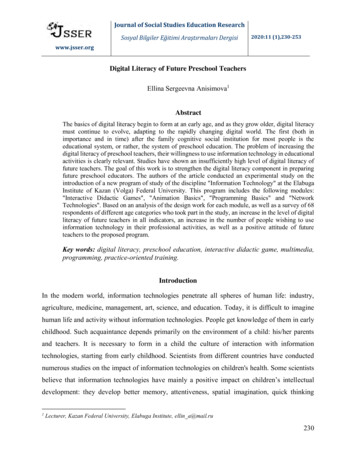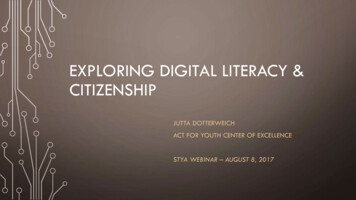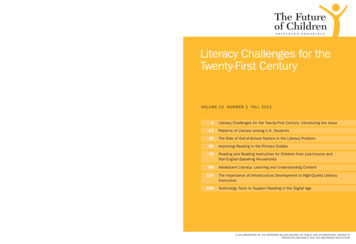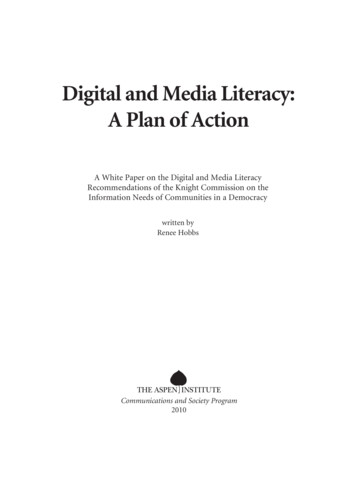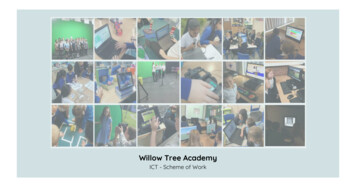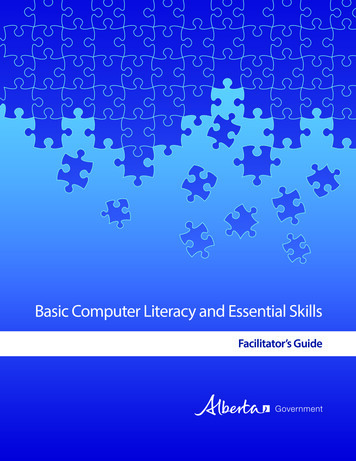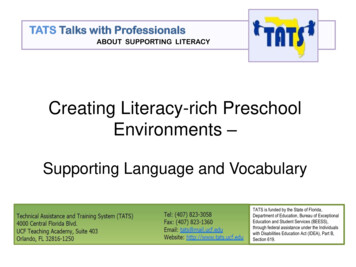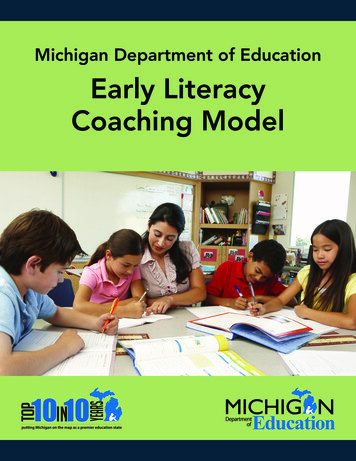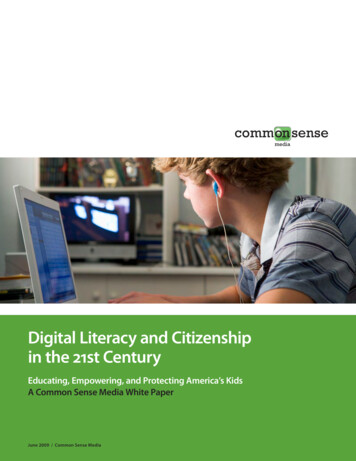
Transcription
Digital Literacy and Citizenshipin the 21st CenturyEducating, Empowering, and Protecting America’s KidsA Common Sense Media White PaperJune 2009 / Common Sense Media
To adults it looks like a bravenew world – but to kids, it’s “just life.”Welcome to their world. 93% of kids 12 to 17 are online 1 More than 13 hours of videos are uploaded to YouTube every minute 2 A majority of teens view their cell phone as the key to their social life 3 If Facebook were a country, it would be the 5th most populous in the world 4 The average 2- to 11-year-old streams more online video than their parents –nearly two hours per month 512345Pew Internet and American Life Project, “Generations Online in 2009”Googleblog, “The Future of Online Video,” September 16, 2008 - nline-video.htmlCTIA – The Wireless Association and Harris Interactive, “Teenagers: A Generation Unplugged,” September 12, 2008Business Insider, April 8, 2009Nielsen Online, June 2008What is Digital Life? Digital life describes the media world our kids inhabit 24/7 – online,on cell phones and mobile devices, and anywhere media is displayed. By definition, digitalmedia is participatory. The users create the content, and anything created in this digitallife becomes instantly viral, scalable, replicable, and viewable by vast, invisible audiences.Kids use digital media to socialize, do their homework, express themselves, and connectto the world. New technologies give our kids unprecedented powers of creation andcommunication, making the world more accessible and comprehensible at earlier andearlier ages.
The Need for Digital Literacy and Citizenship. This dynamic new world requires newcomprehension and communication skills, as well as new codes of conduct, to ensure thatthese powerful media and technologies are used responsibly and ethically. Much ofthe interaction in this digital world happens at a distance, which can diminish the rulesof cause and effect, action and consequence. Additionally, much of digital life takesplace under the cloak of anonymity, making it easier to participate in unethical and evenillegal behaviors.Digital Literacy means the ability to: use technology competently interpret and understand digital content andassess its credibility create, research, and communicate withappropriate toolsDigital Literacy programs are an essential elementof media education and involve basic learning toolsand a curriculum in critical thinking and creativity.Digital Citizenship means that kids appreciate theirresponsibility for their content as well as their actionswhen using the Internet, cell phones, and other digitalmedia. All of us need to develop and practice safe,legal, and ethical behaviors in the digital media age.Digital Citizenship programs involve educational toolsand a basic curriculum for kids, parents, and teachers.1 / Common Sense Media
What’s at stake. America’s children are growing up in the center of a technologicalrevolution. Digital media defines their lives in unprecedented ways; they spend more timeonline, texting, watching TV and movies, and playing video games than they do in schoolor with their parents. The convergence of portable personal technologies, unfilteredaccess to information, and user-generated content profoundly impacts how children growand learn. The line between digital life’s perils and possibilities is thin. The stakes are high.Our kids know more about this world than most of the adults in their lives do.What do we, our kids’ stewards, need todo to ensure that America’s youth willhave the knowledge, ethics, and skillsthey need to harness the power and thepotential of this digital world?This is the central question that requiresurgent attention from policy makers,parents, educators, and the mediaindustry. In partnership, we must createthe teaching and parenting tools thatwill enable us to educate, empower, andyes – protect – our children.2 / Common Sense MediaThe ease with which content andcommunications are created or retrieved,the instantaneous and often anonymousnature of digital communications andcontent creation, the definition ofprivacy as we knew it – all these issuesare now an essential part of a child’seducation. But even the nature, location,and responsibility for this education nowoccurs largely outside the classroom –indeed, the walls have come downbetween school and home altogether.Thus teachers and parents face newand unprecedented challenges andopportunities.
Literacy and CitizenshipGoals for the 21st Century:Educate.Create tools and curricula that teach digital medialiteracy and citizenship.Empower.Give parents and teachers the tools and informationthey need to raise kids to be informed digital citizens.Protect.Define a healthy balance between safe and smartdigital media practices for kids and families and otherimportant societal rights.We have a president in the White Housewho understands what’s at stake. “We’repreparing our kids for 21st-century jobsby sending them through the doorsof 20th-century schools,” he has said onmore than one occasion. PresidentObama is committed to education, and,to him, education and technology areinseparable. He understands that ourfuture leaders must have strong digitaltechnology skills and an unshakableethical foundation underpinning theirbehavior in the digital world.3 / Common Sense Media
This White Paper is an effort to outline essential components of Digital Literacy andCitizenship and to frame the ways that they prepare children to learn and grow in the 21stcentury. Like the digital world itself, the concepts of Digital Literacy and Citizenshipare complex and changing, and this paper is intended for constant updates and revisions,which can be found at s for Teaching Digital Literacy and Citizenship:1Redesign education to include Digital Literacy andCitizenship in every school in America.2Disseminate a basic curriculum that defines thestandards of ethical behavior on digital platforms – forstudents, parents, and educators.3Educate and empower teachers so that they canunderstand and teach Digital Literacy and Citizenship.4 Educate and empower parents about technologyand important behavioral guidelines involving the useof digital media.4 / Common Sense Media
To survive and thrive, today’s students must be digitally literate, which means being ableto use and understand digital technologies and messages. These new media literaciesmust become integral parts of their education, both for traditional studies (reading,writing, math, science) as well as for the 21st-century skills they will need to succeed(creativity, innovation, communication, critical thinking, civic participation). Ensuring that1our kids are prepared for the future requires the following essential initiatives:Redesign education to includeDigital Literacy and Citizenship inevery school in AmericaIncorporate new media literacy intoexisting curricula. Media educationshould be integrated into the curriculumof every school in America. Becauseof the nature of content creation indigital media, kids must be able to usedigital tools to gather, evaluate, andapply information; to evaluate thatinformation intelligently; and to createcontent ethically.Teach basic media education andtechnology skills in schools. Media andtechnological literacy is essential forour kids to succeed – in school and inthe 21st-century workplace. They mustunderstand computers, technologyapplications, and media production toolsthat have an increasingly influentialrole in their lives. Just as importantly,when kids know how to use thesetools, the best elements of technologyand media can be integrated intotheir core curriculum and used toimprove their schools and other learning environments.6 / Common Sense MediaDeepen young people’s communicationand collaboration skills. The increasingly mobile digital media world offersan explosion of ways for kids to connect,communicate, and work together. Theyhave opportunities to engage withothers in their schools, communities, andaround the world. Kids must learn newrules of proper communication andcollaboration if they are to convey andabsorb ideas in a responsible, effective,and pro-social manner.Encourage creativity and innovation.Digital media and technology toolsoffer powerful ways to design and createmedia and user-generated content. Inour rapidly changing world, all kids mustbe able to understand and employ evermore powerful tools – and apply them increative new ways. This creativity shouldbe encouraged, along with a clear understanding of the differences betweencreating, altering, and borrowing.
2 3 4Disseminate a basicDigital Literacy and Citizenshipcurriculum to all schoolsProvide teacher training inthe basics of Digital Literacyand CitizenshipEducate parents aboutdigital technologies, use,and ethicsIn addition to teaching kids the 21stcentury skills of creation, communication,connection, and collaboration, we mustinstruct them in the essentials of DigitalLiteracy and Citizenship so that theywill conduct themselves in ways thatprotect privacy, recognize authorship,and maintain high ethical standards.Teachers across the country need training and preparation in the fundamentalsof Digital Literacy and Citizenship. Manyof today’s teachers and administratorslag behind their students in understanding and using technology anddigital media. Teachers must understandthe basic technologies and applications,as well as what their students are doingwith them, if they are to teach 21stcentury skills and ethics successfully.A parent’s job is to protect and guide.Parents desperately need to understandnot only the technologies that informtheir children’s lives, but also the issuesaround behavior and responsibleuse. Rather than seek only legislativeprotections in a world that is constantlydeveloping, the first course of actionshould be to give parents the information and tools they need to teachtheir children about responsible, safe,and ethical behavior in the digital world.Curriculum tools and resources – not amandated national curriculum – will helpschools teach kids to appreciate theirresponsibility for their content and theiractions and to develop and practice safe,legal, and responsible behaviors for thedigital world.Teachers also need professional development and guidance about how toconnect formal learning environments(schools) with informal learningenvironments (after-school programs,libraries, homes) as digital media andtechnology continue to break down thewalls between the two.7 / Common Sense Media
Developing Digital Literacy and Citizenship Programs. There are several necessary steps todevelop Digital Literacy and Citizenship programs for every child in America:1Fund professional developmentfor educators Create a national Digital TeacherCorps – along the lines of AmeriCorpsand Teach for America – for on-siteeducator training. This organizationwould provide professional development and in-service training foreducators to improve their facility withtechnology and media, and with basictenets of digital learning. Provide professional development andsupport through existing structures,including state Departments ofEducation and community college anduniversity systems.8 / Common Sense Media
2 3 4Create basic resources foreducating teachers, parents,and kidsFund and deliver education /technology resources in underserved schools and communitiesMake media education andDigital Literacy an essential part ofevery school’s basic curriculumCurriculum resources and tools forDigital Literacy and Citizenship are beingdeveloped by Common Sense Mediaand other education groups. These toolsmust reflect the constant changes ofthe media world. Digital Literacy andCitizenship cannot be taught withtextbooks that are outdated before theyare published. These issues must bepresented through the Internet andother digital media, on flexible platformsthat can be regularly redefined with newinformation and experiences. In addition,Digital Literacy and Citizenship programsmust be modular and scalable – notentirely new subjects, but lessons andideas that can be incorporated into existing curricula at each age and grade level. Fund and train technology supportand staff development for underserved districts to ensure that digitalmedia and technology are fullyintegrated into the neediest schools.Digital Literacy and Citizenship are ideasand concepts that should be incorporated into existing courses – includingEnglish, math, science, and history – ateach age and grade level in all K-12schools in the United States. We mustensure that kids learn rules for safe andsmart use of digital media in order tomake the most of the educationalopportunities that digital media creates. Fund and hire a national corps oftechnology support specialists. Continue to upgrade and / or retoolschool facilities and equipment. Coordinate efforts with other relatedlegislation and funding.Finally, curriculum and educationalresources for teachers, students, andparents should be disseminated throughthe schools, as well as communityprograms (e.g. Boys and Girls Clubs),after-school activities, and parentengagement networks (e.g. PTAs).9 / Common Sense Media
What do we get if we do this? It is perfectly clear: The nation whose children best harnessthe educational and creative powers of digital media will write the economic andeducational success story of the 21st century. Digital media is bringing significant changesto the ways that kids live and learn – and those changes can create opportunities orpose potential dangers. We need to fund teachers, curricula, and parenting tools thatteach kids to understand and manage media’s role in their lives. The emerging fieldsof Digital Literacy and Citizenship are the keys to that preparation. They deserve America’sinvestment and leadership today.
Common Sense Media Board of DirectorsRich BartonChair, CEO and Founding Partner, Zillow.comMarcy CarseyFounding Partner, Carsey – Werner ProductionsJames G. CoulterFounding Partner, TPG CapitalGeoffrey CowanUniversity Professor, The Annenberg School forCommunication at USCApril McClain DelaneyAttorneySusan Ford DorseyPresident, Sand Hill FoundationJohn H.N. FisherManaging Director, Draper Fisher JurvetsonLycia Carmody FriedCivic LeaderJulius GenachowskiCo-Founder, LaunchBox DigitalTom HollandPartner, Bain & Company, Inc.William E. KennardManaging Director, The Carlyle Group; former FCC ChairmanGary E. KnellPresident and CEO, Sesame WorkshopRobert L. MillerPresident and CEO, Miller Publishing GroupCarrie Schwab PomerantzPresident, Charles Schwab FoundationWilliam S. Price, III(Chair)Investor, Co-Founder TPG CapitalJesse RogersCo-Founder and Managing Director, Golden Gate CapitalSusan SachsFormer COO, Common Sense MediaJames P. SteyerFounder and CEO, Common Sense MediaMike TollinPrincipal, Tollin ProductionsEugene Washington, M.D.Executive Vice Chancellor, UCSFLawrence Wilkinson(Vice Chair)Co-Founder, Oxygen Media and Global Business Network11 / Common Sense Media
Common Sense Media Board of Advisors12 / Common Sense MediaAileen AdamsFellow, Harvard University, Women and Public Policy ProgramLarry BaerExecutive Vice President and Chief Operating Officer,San Francisco GiantsRichard I. BeattieChairman, Simpson Thacher & Bartlett LLPAngela Glover BlackwellFounder and CEO, PolicyLinkRamon C. CortinesSuperintendent, Los Angeles Unified School DistrictYogen DalalManaging Director, Mayfield FundSteven A. DenningChairman, General Atlantic LLCMillard DrexlerChairman and CEO, J. CrewEzekiel J. Emanuel, M.D., Ph.D.Chair, Department of Clinical Bioethics,The National Institutes of HealthRobert J. FisherDirector, Gap Inc.Arjun GuptaFounder and Managing Partner, Telesoft PartnersElizabeth HambrechtChief Executive Officer, Salon.comF. Warren HellmanFounding Partner and Chairman, Hellman & Friedman LLCJames H. Herbert, IIChairman and Chief Executive OfficerDavid HornikGeneral Partner, August CapitalDonald Kennedy, Ph.D.President Emeritus, Stanford University; former Editor-in-Chief,Science MagazineOmar KhanPresident, Insight Strategy & LogicNion McEvoyChairman and CEO, Chronicle Books LLCNell MinowFounder, The Corporate Library and Movie MomRebecca Q. MorganPresident, Morgan Family FoundationNancy PeretsmanExecutive Vice President and Managing Director,Allen & CompanyGeorge RobertsFounding Partner, Kohlberg Kravis Roberts & Co.Alan SchwartzPrivate Investor, Thomas Steyer Founding Partner,Farallon CapitalGene T. SykesManaging Director, Goldman, Sachs & Co.Todor TashevDirector, Omidyar NetworkRobert S. TownsendPartner; Chair, Corporate Practice Group,Morrison & Foerster LLPLaura R. WalkerPresident and CEO, New York Public RadioAlice WatersFounder, Chez Panisse and Chez Panisse FoundationTim ZagatCo-Founder, Co-Chair, and CEO, Zagat Survey
Policy AdvisorsAngela Glover BlackwellFounder and CEO, PolicyLinkEzekiel J. Emanuel, M.D., Ph.D.Chair, Department of Clinical Bioethics,The National Institutes of HealthMichael Cohen, Ph.D.President, The Michael Cohen GroupEllen GalinskyPresident and Co-Founder, Families and Work InstituteAndrew GreenbergFounder and President, Greenberg Qualitative Research, Inc.Denis HayesPresident and CEO, The Bullitt FoundationDavid Lawrence Jr.President, The Early Childhood Initiative FoundationWendy LazarusFounder and Co-President, The Children’s PartnershipChristopher LehanePolitical Communications ExpertLaurie LipperFounder and Co-President, The Children’s PartnershipJames MontoyaSenior Vice President, The College BoardPhilip A. Pizzo, M.D.Dean, Stanford University School of MedicineMichael PosnerPresident, Human Rights FirstCommon Sense Media is the nation’s leading nonpartisanorganization dedicated to improving the media and entertainmentlives of kids and families. Go to www.commonsensemedia.orgfor thousands of reviews and expert advice.
Common Sense Media650 Townsend Street, Suite 375San Francisco, CA 94103(415) 863.0600www.commonsensemedia.org
preparing our kids for 21st-century jobs by sending them through the doors of 20th-century schools," he has said on more than one occasion. President Obama is committed to education, and, to him, education and technology are inseparable. He understands that our future leaders must have strong digital technology skills and an unshakable
